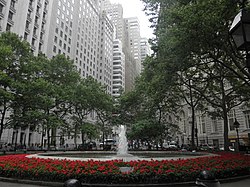
Back Bowling Green (parke sa Tinipong Bansa, New York) CEB Bowling Green (New York City) German Bowling Green (parque) Spanish Bowling Green (park) Estonian Bowling Green (New York) French Bowling Green (New York City) Hungarian ボウリング・グリーン (ニューヨーク市) Japanese 볼링 그린 (뉴욕) Korean Bowling Green (park) Dutch باؤلنگ گرین PNB
Bowling Green Fence and Park | |
 Bowling Green looking north from the fountain | |
 | |
| Location | Southern end of Broadway, Manhattan, New York |
|---|---|
| Coordinates | 40°42′18″N 74°0′49″W / 40.70500°N 74.01361°W |
| Built | 1733 |
| Part of | Wall Street Historic District (ID07000063[2]) |
| NRHP reference No. | 80002673 |
| Significant dates | |
| Added to NRHP | April 9, 1980[1] |
| Designated CP | February 20, 2007 |
Bowling Green is a small, historic, public park in the Financial District of Lower Manhattan, New York City, at the southern end and address origin of Broadway. Located in the 18th century next to the site of the original Dutch fort of New Amsterdam, it served as a public gathering place and under the English was designated as a park in 1733. It is the oldest public park in New York City and is surrounded by its original 18th-century cast iron fence. The park included an actual bowling green and a monumental equestrian statue of King George III prior to the American Revolutionary War. Pulled down during the revolution, the 4000-pound statue is said to have been melted for ammunition to fight the British.
Bowling Green is adjacent to another historic park, Battery Park, located to the southwest. It is surrounded by several buildings, including the Alexander Hamilton U.S. Custom House (with the NYC office of the National Archives), the International Mercantile Marine Company Building, Bowling Green Offices Building, Cunard Building, 26 Broadway, and 2 Broadway. The Charging Bull sculpture is located on the northern end of the park. The park is listed on the U.S. National Register of Historic Places under the name Bowling Green Fence and Park. It is also a contributing property to the Wall Street Historic District, an NRHP district created in 2007.[2]
- ^ "National Register Information System". National Register of Historic Places. National Park Service. April 15, 2008.
- ^ a b Howe, Kathy; Robins, Anthony (August 3, 2006). "National Register of Historic Places Registration Form: Wall Street Historic District". National Register of Historic Places. Retrieved July 7, 2024 – via National Archives.